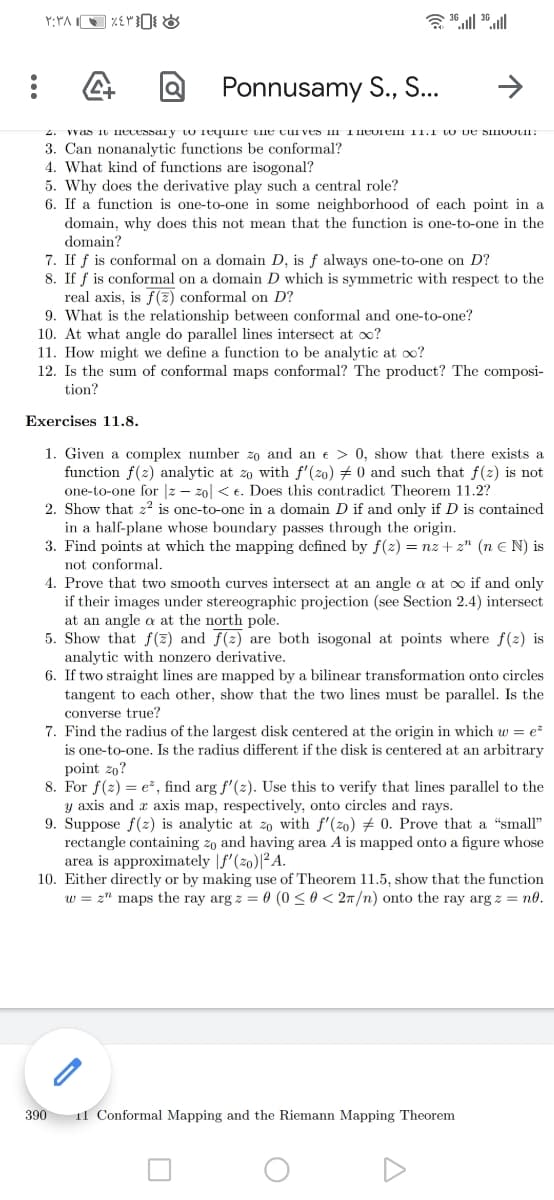What kind of functions are isogonal?
Algebra & Trigonometry with Analytic Geometry
13th Edition
ISBN:9781133382119
Author:Swokowski
Publisher:Swokowski
Chapter7: Analytic Trigonometry
Section7.6: The Inverse Trigonometric Functions
Problem 91E
Related questions
Topic Video
Question
q 4

Transcribed Image Text:Ponnusamy S., S...
vvas 10 necessai y w Tequine uie cui ves nl Theorem 11.1 to De SIIOOLII:
3. Can nonanalytic functions be conformal?
4. What kind of functions are isogonal?
5. Why does the derivative play such a central role?
6. If a function is one-to-one in some neighborhood of each point in a
domain, why does this not mean that the function is one-to-one in the
domain?
7. If f is conformal on a domain D, is f always one-to-one on D?
8. If f is conformal on a domain D which is symmetric with respect to the
real axis, is f(z) conformal on D?
9. What is the relationship between conformal and one-to-one?
10. At what angle do parallel lines intersect at oo?
11. How might we define a function to be analytic at o?
12. Is the sum of conformal maps conformal? The product? The composi-
tion?
Exercises 11.8.
1. Given a complex number zo and an e > 0, show that there exists a
function f(2) analytic at zo with f'(20) + 0 and such that f(2) is not
one-to-one for |z – z0| < e. Does this contradict Theorem 11.2?
2. Show that z? is one-to-one in a domain D if and only if D is contained
in a half-plane whose boundary passes through the origin.
3. Find points at which the mapping defined by f(z) = nz + z" (n E N) is
not conformal.
4. Prove that two smooth curves intersect at an angle a at oo if and only
if their images under stereographic projection (see Section 2.4) intersect
at an angle a at the north pole.
5. Show that f(z) and f(2) are both isogonal at points where f(2) is
analytic with nonzero derivative.
6. If two straight lines are mapped by a bilinear transformation onto circles
tangent to each other, show that the two lines must be parallel. Is the
converse true?
7. Find the radius of the largest disk centered at the origin in which w = e
is one-to-one. Is the radius different if the disk is centered at an arbitrary
point 20?
8. For f(z) = e-, find arg f'(2). Use this to verify that lines parallel to the
y axis and a axis map, respectively, onto circles and rays.
9. Suppose f(2) is analytic at zo with f'(zo) # 0. Prove that a "small"
rectangle containing zo and having area A is mapped onto a figure whose
area is approximately |f'(zo)|²A.
10. Either directly or by making use of Theorem 11.5, show that the function
w = z" maps the ray arg z = 0 (0 <0 < 27/n) onto the ray arg z = no.
390
Il Conformal Mapping and the Riemann Mapping Theorem
Expert Solution
This question has been solved!
Explore an expertly crafted, step-by-step solution for a thorough understanding of key concepts.
This is a popular solution!
Trending now
This is a popular solution!
Step by step
Solved in 2 steps

Knowledge Booster
Learn more about
Need a deep-dive on the concept behind this application? Look no further. Learn more about this topic, advanced-math and related others by exploring similar questions and additional content below.Recommended textbooks for you

Algebra & Trigonometry with Analytic Geometry
Algebra
ISBN:
9781133382119
Author:
Swokowski
Publisher:
Cengage


Algebra & Trigonometry with Analytic Geometry
Algebra
ISBN:
9781133382119
Author:
Swokowski
Publisher:
Cengage
